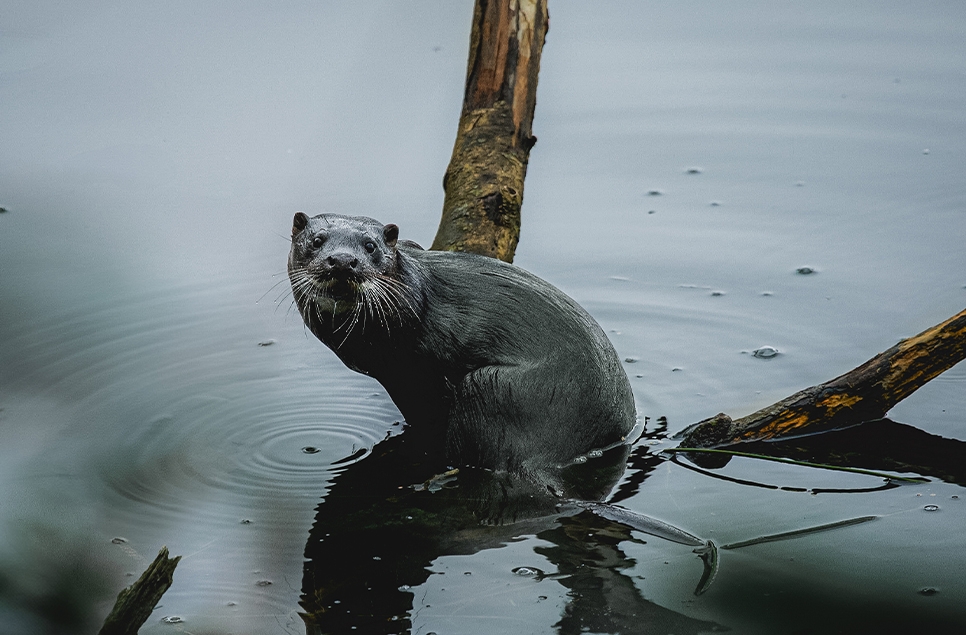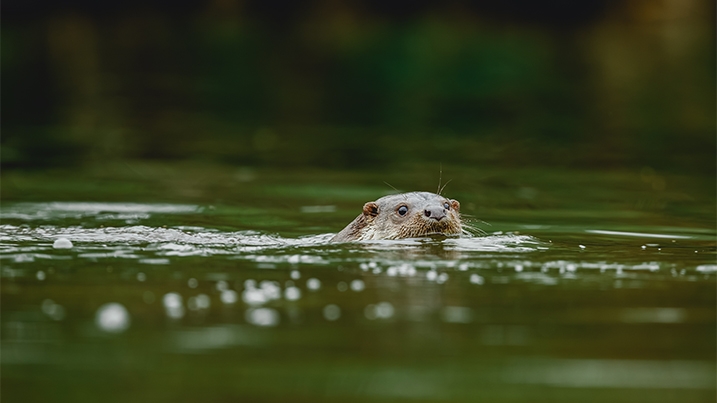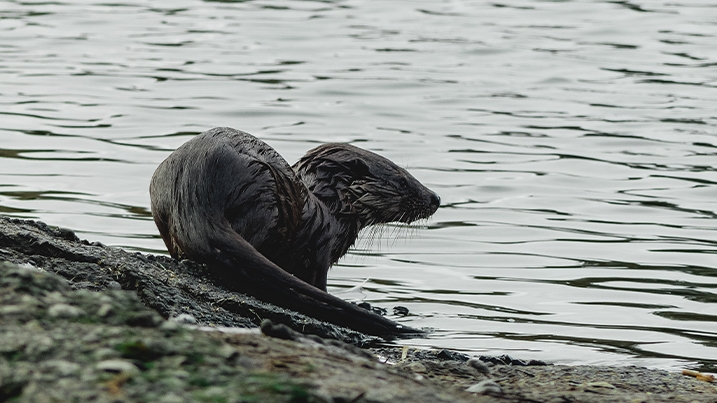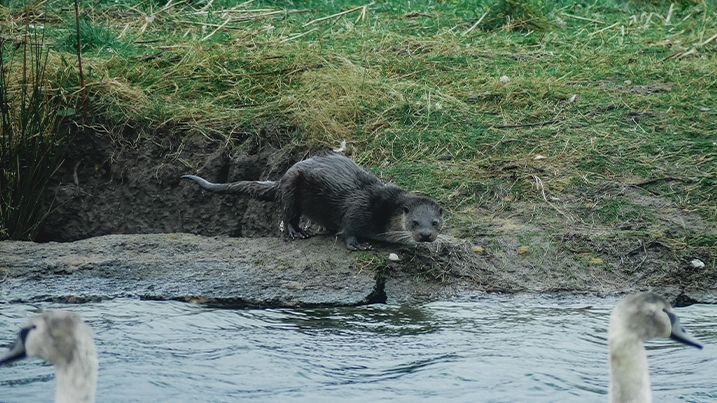12 tips to spot an otter in the wild
Beautiful and playful, wild otters are notoriously hard to see. Find out how you can improve your chances of spotting this elusive predator.

Of the 13 otter species worldwide, only one is found in Europe. The Eurasian otter. Happily, it’s doing well in the UK since its sad decline in the 1950s.
You’re likely to find these sinuous swimmers hunting in wetlands, rivers and along the coast. They also make use of dense vegetation and woodland where they rest and breed in their ‘holts’.
Follow our tips for the best chance of tracking them down.
1. Scan the surface

Otters are barely visible as they swim. But there are clues to look out for on the water’s surface. If you’re lucky, you might spot their head and back as they move effortlessly through the water. Or from a distance you might see the v-shaped wave they leave behind them.
And as they dive you could catch a glimpse of their tail or spot a stream of bubbles left in their wake. They can hold their breath for up to 30 seconds and can pop up several meters away. So keep scanning the water to see them breach the surface again.
You may also see movement in the reeds, as they use the vegetation around the edge of rivers and wetlands to mask their movements.
2. Keep an ear out
Listen out for scrabbling, splashing and squeaking. Otters are noisy creatures and you’re likely to hear them before you see them.
3. Sniff them out
It’s hard to believe, but otter droppings are often described as sweet smelling, like flowers or jasmine tea! They use them as ‘scented messages’ and to mark their territory. Look for their greeny-black droppings or ‘spraints’ along riverbanks or on rocks.
They’re worth a closer look too, as they’re full of clues to what the otters have been eating. You might be able to see glittery fish scales, shells, feather and fur. Or the tiny bones of a small mammal.
4. Get tracking

If you don’t fancy sniffing their droppings, keep an eye out for their tracks instead. They’re easy to identify. Look for the tell-tale five claws which sets them apart from most other animals. Even if their claw marks can’t be seen, you might be able to see the webbing.
Some of the best places to search for their tracks are on a sandy beach first thing in the morning, or along muddy riverbanks. Another tell-tale sign an otter is nearby is a muddy, semi-circular slide into the river.
5. Know their haunts
Otters can often be found under or near bridges. Another good place to look is on banksides or boulders and rocks either in or near rivers. Or search them out on gravel banks or at river junctions or intersections.
6. Pick your time
Otters are usually nocturnal and feed at dawn and dusk. So the best time for otter spotting is generally around these times.
And while they breed all year round, in the UK they tend to have their pups in the summer. The mother raises her young without help from the male and after about 10 weeks takes them for their first swim.
A good time to spot and sometimes hear an otter is when a female is showing her pups how to hunt and navigate their territory. The pups often give out contact calls which can give away their location.
7. Search out a healthy wetland
Otters mostly feed on fish like trout, carp and eels. Although they sometimes also look for birds, eggs, insects and small mammals. They’ll usually eat more than 2Ibs of food a day and are even capable of catching prey equivalent to their own body weight.
Healthy wetlands rich in wildlife that can provide enough food to sustain an otter are one of your best bets if you want some otter action.
8. Keep it quiet
Otters are wary and easily disturbed. So, stay still and quiet to maximise your chances of seeing one.
And remember, otters are legally protected which is partly what’s helped their numbers increase. Getting too close and disturbing wild otters is an offence.
9. Watch the birds

Gulls will follow the route of an otter, hoping to claim a fish scrap. Look for low flying gulls over the river, as chances are they’ve spotted an otter and will keep an eye on it.
Also, look out for unusual behaviour from ducks. If an otter is around, they’ll suddenly become alert and their eyes will be fixed on the same spot. Diving ducks will swim towards the edges of a lake or river.
10. Visit a WWT wetland centre
There are wild otters living on all our wetland reserves.
At WWT Washington, our Saline Lagoon Hide provides occasional views of otters hunting, often catching fishy prey such as flounder and trout. Our Lagoon View hide also offers great views of the River Wear. This would be a great place to spend time until the centre closes.
At WWT Slimbridge we record regular ‘Trailcam’ footage of our resident otter family as the mum expertly guides her two cubs around the reserve to fish in our wetlands.
The best place to spot them is the South Finger where they’ve been seen several times next to the hides.
If you can’t make it to Slimbridge, you can keep up to date with our Slimbridge otter action via our trail cameras which we regularly publish on our X account.
At WWT Llanelli otters are a constant presence on the Millennium Wetlands reserve, although we rarely see them in the flesh. The reserve is well connected by ditches and channels making it easy for them to travel about. We believe they’re using the whole reserve and may even be travelling out beyond the saltmarsh to the Loughor Estuary.
If you want a better chance of seeing them, head to our Deep Water Lake where you can see them playing and fishing from the Herons Wing Hide. Three otters have been spotted there in recent weeks. We think they’re juveniles, due to their size and behaviour, which is very promising for the local otter population.
11. Talk to those in the know
On arrival at any of our wetlands, feel free to ask any of our staff and volunteers if any otters have been seen that day. When you’re visiting chat to other visitors too. Chances are our regular members might have seen an otter and be happy to share their knowledge with you.
Another good idea is to check our latest sightings pages. You can also keep a look out on our sites’ social media feeds too, as visitors often post details of otter sightings.
12. The best things come to those who wait
Have patience. Like most wildlife encounters, they can take time. But an otter sighting isn’t just a sighting. It’s a special event and one you’ll remember for a long time!
Creating otter friendly wetlands
We carefully manage our wetlands to encourage otters onto our sites.
Otters hunt over a large territory and can cover miles of rivers and other waterways to find enough food. So, one of the ways we support them is by providing bigger, better more connected wetlands.
We dig and restore ditches across our reserves. We also remove barriers to encourage more eels and fish into our wetlands, so making it easier for otters to hunt and move around.
We also entice them with well-maintained reedbeds. They love these because of their secluded nature and also because they act as fish nurseries and offer good hunting.
We also create hedges where otters can feed without interruption. Being undisturbed is important for them and each individual will have several hideaways out of sight within tree roots, in drains or culverts.
At some of our sites we’ve also introduced man made holts to encourage otters to stay in the area and breed.
A guaranteed sighting
If you’re struggling to spot an otter in the wild, why not visit Martin Mere, Washington, London Wetland Centre or Slimbridge to see some of our resident Asian short-clawed otters?
Meeting Tod and Honey is undoubtedly one of the highlights of any trip to London Wetland Centre. While Mimi, Musa and their son Buster are sure to put on a show for any visitors to WWT Washington.
We also have otters at WWT Martin Mere who are flourishing thanks to an extension to their enclosure. While summer 2023 saw us welcome Sam and Tilly, our two ‘otterly’ cute new arrivals at Slimbridge. Watch them as they enjoy their brand new holt complete with living roof.
Header image - Otter at Castle Espie © Ben Bowler



